
8 Filemaker Alternatives & Competitors for 2025
Claris FileMaker Pro is one of the oldest names in the low-code space. Claris is a subsidiary of Apple, so FileMaker was long thought of as essentially being a Microsoft Access alternative for Mac users. Today, the picture is quite a bit different.
This is an important piece of context because it means that FileMaker started life as an integrated relational database engine and GUI. This remains a key part of its core offering, but it’s also evolved to include functionality around building custom interfaces and automations, as well as extensive capabilities for leveraging AI within app projects.
FileMaker can be a powerful solution, but it isn’t for everyone. Today, we’re situating it in the wide low-code market as we check out some of the top FileMaker alternatives.
Along the way, we’ll also present you with a full account of how you can choose the right platform based on your real-world needs, target users, data ops, use cases, and more.
Specifically, we’re going to cover:
- What is FileMaker?
- Who uses FileMaker?
- Why would you need a FileMaker alternative?
- 8 FileMaker alternatives
- FileMaker vs Budibase
- How to choose a FileMaker alternative
Let’s jump in.
What is FileMaker?
Launched in the mid-1980s, FileMaker is a low-code tool for creating and managing databases - as well as building applications on top of stored data. It’s available as a local package on Windows and Mac, as well as in a cloud-based service.
The goal is to provide users with a drag-and-drop interface for establishing and populating database schemas, as well as building user interfaces for interactions with this data.
It’s primarily aimed at facilitating data management tasks, including CRUD operations, validation, storage, auditing, and governing access. On top of this, it’s popular for automating menial tasks and creating simple applications, including forms, reports, and other UIs.
More rcently, Claris has also introduced a whole suite of AI capabilties in FileMaker. This includes tools for using data alongside LLMs, document retreival and extraction, natural language search, and generating AI-powered responses for end users.
AI features can be powered by public models like OpenAI, Anthropic, and Cohere, or the locally-hosted model of your choice.
Helpfully, FileMaker provides dedicated functionality for shipping native web and mobile apps, making it a great solution for teams that need to output cross-platform solutions. For more technical users, it also integrates with JavaScript, PHP, HTML, XML, and other tools.
Who uses FileMaker?
FileMaker is particularly popular among SMBs. One way of thinking about its niche is scenarios where data volumes are too large for spreadsheets to be tenable but the users tasked with managing this data lack the technical skills for a traditional RDBMS.
As such, FileMaker users often aren’t professional developers - or even IT professionals. Rather, it’s used heavily by departmental leaders, business technologists, project managers, and other colleagues who need an accessible way to control internal data assets.
Where technical colleagues are involved, FileMaker is typically used as a means to output simple internal tools quickly - especially by already overburdened IT teams. For example, in industries like education or smaller-scale inventory, HR, and customer-facing contexts.
We’ve already hinted at some of the key use cases. On top of forms and reporting, FileMaker is also a strong option for building CRUD tools, admin panels, portals, and approval apps on top of stored data or external data sources via API or ODBC connections.
Why would you need a FileMaker alternative?
FileMaker has been around for a very long time - especially in the context of the wider low-code market. The trouble is that this space has experienced huge disruption over the past few years and legacy vendors have struggled to keep pace.
For example, many users complain that it lags behind newer platforms in terms of both capabilities and developer experiences. Compared to some newer competitors, it may also present a relatively steep learning curve.
For example, although the drag-and-drop interface designer is perfectly intuitive, it’s somewhat more limited in terms of customization than some other platforms on the market, as we’ll see shortly.
FileMaker is also designed to be sticky. That is, the intention is for teams to adopt FileMaker and continue using it for storing data in the long term. We can connect to external databases in our apps, but we’ll need to this up with ODBC, rather than using native connectors.
On top of this, FileMaker hasn’t always kept pace with changes to the way businesses handle data over the past decade or so.
For example, handling unstructured data in NoSQL databases may be possible via API connections, but experiences for doing so are not streamlined. If this is important to you, you’ll want to look elsewhere.
Finally, as with any other IT procurement decision, you may determine that FileMaker could be a viable solution for your particular use case - but that other vendors offer a more cost-effective way to achieve the same thing.
You might also like our round-up of the top Quickbase alternatives .
8 FileMaker alternatives
With a fuller picture of what FileMaker is and what it does, we can start to survey the wider market.
First, though, we should make a couple of general points. The market for low-code platforms has a huge amount of internal variation. Different vendors take a different approach to helping teams improve their internal data operations.
So, some tools want to lock users into their platform as a database and application builder, while others still provide an internal database, but make it easier to handle external data.
Similarly, platforms vary in terms of the kinds of users they empower to build solutions - with vendors variously targeting non-technical users, professional developers, and all places in between.
Our top picks for FileMaker alternatives are:
Here’s a summary of what each one brings to the table.
 Filemaker |  Budibase |  Retool |  Mendix |  PowerApps |  Appian |  Outsystems |  Airtable |  Zoho Creator | |
|---|---|---|---|---|---|---|---|---|---|
| Pricing Model | Per user | Per creator + per user | Per creator + per user | Flat fee + per user | Per user | Per user + usage-based | Custom | Per user | Per user |
| Built-In Database | |||||||||
| RBAC | |||||||||
| Custom Components | |||||||||
| Automation Builder | Via Power Automate | ||||||||
| SSO | Paid | Free | Paid | Paid | Paid | Paid | Paid | Paid | Paid |
| Security certs | ISO27001 SOC 2 | ISO27001 | SOC 2 | ISO27001 SOC 2 | ISO27001 SOC 2 | ISO27001 SOC 2 | ISO27001 | ISO27001 SOC 2 | ISO27001 SOC 2 |
| Audit Logs | |||||||||
| App Embeds |
Let’s check each one out in turn.
1. Budibase
Budibase is the open-source, low-code platform that empowers IT teams to turn data into action. Like FileMaker, we offer a built-in database, a drag-and-drop UI builder with front-end scripting, and a range of tools for automating and managing internal processes - including leveraging LLMs.
However, unlike FileMaker, Budibase is fully optimized for busy IT teams in large organizations that need to output professional solutions at pace.

Features
Whereas external data sources must be configured manually in many FileMaker alternatives using API requests and ODBC, we offer a range of dedicated connectors for SQL and NoSQL databases, as well as REST APIs, Google Sheets, and more. You can use our visual editor to create custom filtering and transformation views, assign them to custom user roles, and autogenerate secure screens and automations in just a few clicks.
We also offer a built-in low-code database with full support for CSV imports and a spreadsheet-like interface for performing CRUD actions or altering table schemas. Budibase users can even create their own custom data sources using our CLI tools.
Our interface designer makes custom coding totally optional. We offer a range of tools for building highly advanced user experiences without writing a single line of code - including autogenerating app screens, and adding conditionality, mobile responsiveness, app theming, and more.
Budibase also makes it incredibly easy to automate manual tasks. Use our flow-chart-based automation builder to craft custom rules by configuring a huge range of built-in triggers and actions, including looping or branching logic. We offer a range of AI operations in the Data and Automation sections, powered by OpenAI, Azure, or Budibase AI.
We even offer free SSO, optional self-hosting, custom branding, flexible visual RBAC, and more. With Budibase Workspaces, teams can now reuse data and automations across all applications in a given Workspace.
Use cases
Budibase is the ideal solution for IT teams that struggle to keep pace with the demand for custom internal tools.
Solutions architects, data specialists, product owners, systems engineers, and other IT professionals choose our platform to ship tools without using up internal development resources.
Budibase is ideally suited to building all sorts of workflow apps, including forms, approval tools, CRUD solutions, portals, admin panels, dashboards, and other internal tools.
In particular, Budibase excels at enabling teams to build efficient user experiences based on a wide range of existing data sources.
Pricing
Budibase is priced on a per-user basis, distinguishing between the colleagues who build apps and the ones who use them. This means it’s incredibly cost-effective to scale as your needs evolve and grow.
We also offer one of the most generous free tiers in the low-code market. Build unlimited applications with as many data sources as you want for up to five users in the cloud or twenty if you self-host. We even offer free SSO.
Our Premium tier bills at $50 per month for creators and $5 for end users with custom branding, configurable views, app backups, and more.
We also offer custom enterprise pricing with a range of advanced security features.
2. PowerApps
PowerApps is one of FileMaker’s most direct competitors. It’s Microsoft’s low-code offering and the flagship of their Power Platform ecosystem.
It’s a particularly good choice for businesses for businesses that are already heavily embedded in the Microsoft ecosystem. However, there are a few key areas where it could fall short for users who are not.
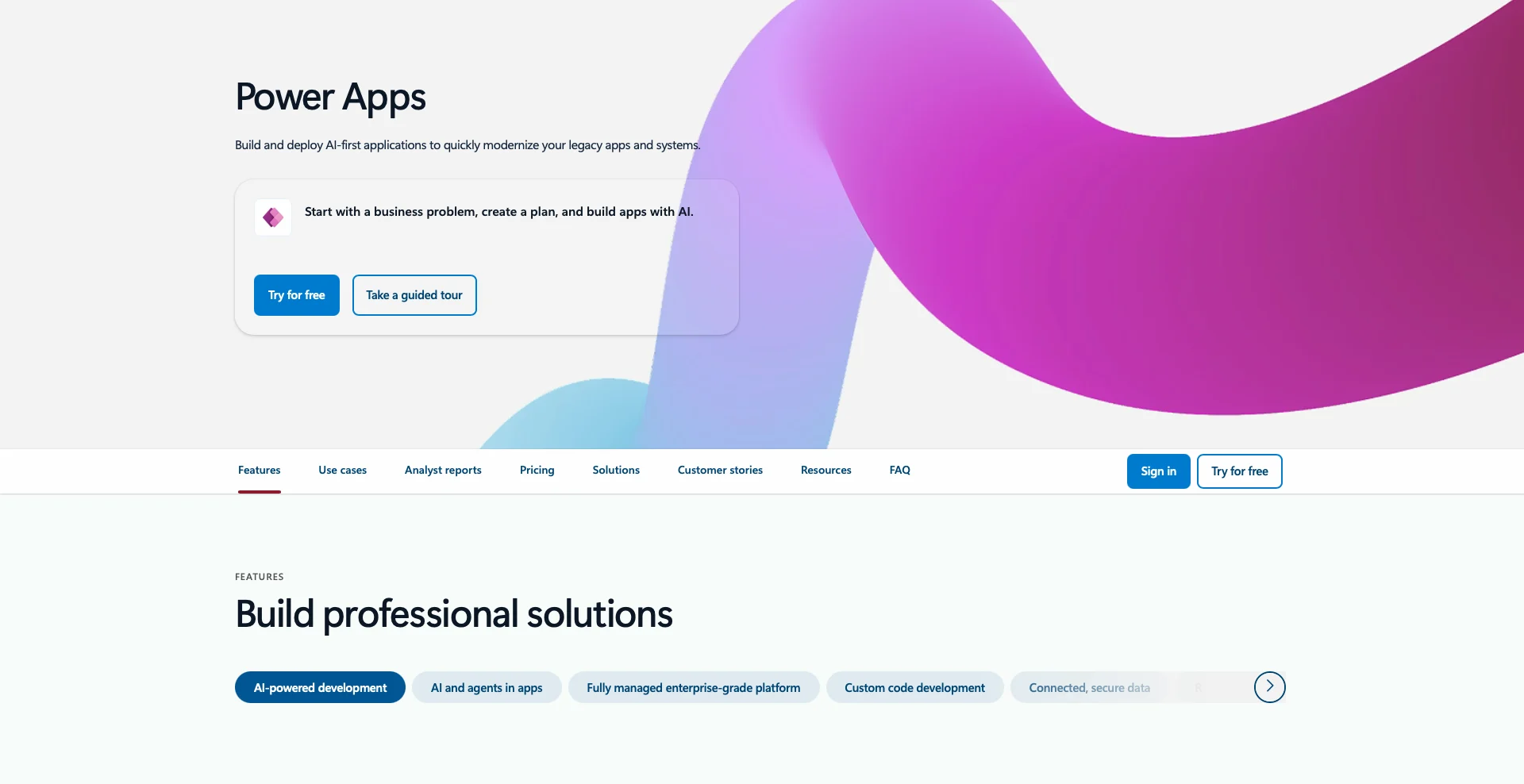 (PowerApps Website)
(PowerApps Website)
Pros
As we hinted at, PowerApps works very neatly across other tools in the Power Platform and Office365 ecosystems. So, it offers integrations with Power Automation, SharePoint, Dynamics, PowerBI, SQL Server, and more.
It’s a low-code platform, but it uses its own proprietary scripting language called Power Fx. This very closely resembles the kind of formulae that most business users will be familiar with from Excel, so adding custom logic can be relatively easy.
On top of this, Microsoft provides a huge range of templates for various use cases to help get you started with PowerApps
Cons
PowerApps’ biggest downside is its steep learning curve. We said a second ago that Power Fx is relatively familiar, but we nonetheless need to learn it in order to get the full effect of using the platform.
It’s also very strict syntactically and many Power Apps users complain that it can be very difficult to get functions to work as intended without effective error messaging.
PowerApps also lacks some of the key functionality of other FileMaker alternatives. For instance, it can’t be self-hosted. You’ll also need a separate license for Power Automate if you want to build complex automations.
Pricing
One reason for Power Apps’ popularity is its simple, comparatively affordable pricing model. There’s a working free tier, with limitations on stored data and automation runs. On the Premium plan users are billed at $20 per month - whether they’re creators or end users. This scales down to $12 if we have more than 2,000 seats.
However, related platforms like Power Automate or Co Pilot Studio - which you might also need - bill separately.
A PowerApps license enables us to build as many applications as we want, although there are other usage limitations, including around data and automation runs.
3. Retool
Retool is probably the best-known modern low-code platform. Launched in 2017, it’s played a big role in the growing popularity of low-code over the past few years.
However, unlike most of the other tools we’ll see today, it’s aimed squarely at professional developers. This means that it offers a relatively high degree of flexibility and customization but at the expense of usability for less technical colleagues.
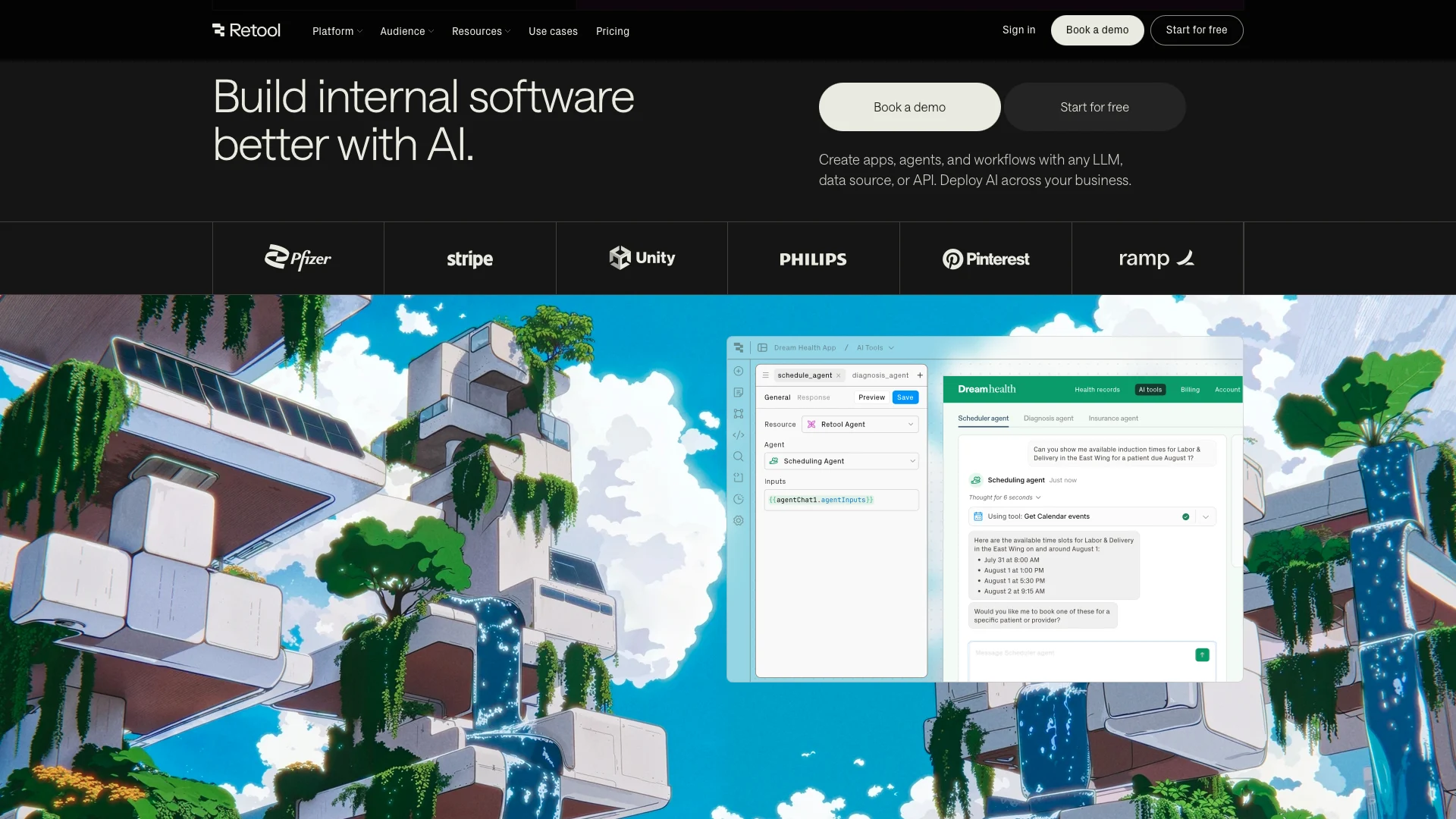 (Retool Website)
(Retool Website)
Pros
Retool took a large market share away from platforms like FileMaker and PowerApps by offering intuitive, efficient developer experiences. It offers a powerful drag-and-drop builder for adding components and configuring them with custom code.
It also offers strong experiences around configuring your data layer. Unlike FileMaker, there are a range of dedicated connectors for external databases - so we don’t have to set this up manually via ODBC.
Retool also offers a flexible, flow-based automation builder. This gives developers extensive scope for adding custom code, branching logic, and more. On top of this, they’ve recently launcehd a range of agentic AI capabilities.
Cons
Retool is a developer-focused platform, first and foremost. This isn’t a criticism as such - but it means that we’re more likely to need to write custom code for any given use case than we are with the other FileMaker alternatives in this list.
So, we might want want to look for a less code-intensive, or even a no-code option if we want to empower other types of colleagues to build applications.
Retool is also closed-source, so we may want to look elsewhere if this is a firm requirement.
Pricing
Retool has a four-tier billing model - Free, Team, Business, and Enterprise. Like Budibase, it charges differently for developers and end users, which helps with scalability.
However, each pricing tier also introduces other restrictions. For example, the Team tier bills at $10 per month for developers and $5 for end users, but limits us to 5,000 automation runs. We’d need to go for a more expensive plan to overcome this limit.
Key functionalities like custom branding and SSO are reserved for the Enterprise tier, which also has the potential to make Retool a very expensive option if these are firm requirements.
Take a look at our round-up of the top Retool alternatives .
4. Appian
Appian occupies a slightly different corner of the low-code market. Like FileMaker, it still offers a built-in database and visual interface for building app UIs.
However, it positions itself as a process automation tool as much as an app builder, including extensive capabilities for leveraging AI within workflows. Naturally, there’s a lot of overlap here, but it means that the priorities are a little bit different than with other FileMaker alternatives.
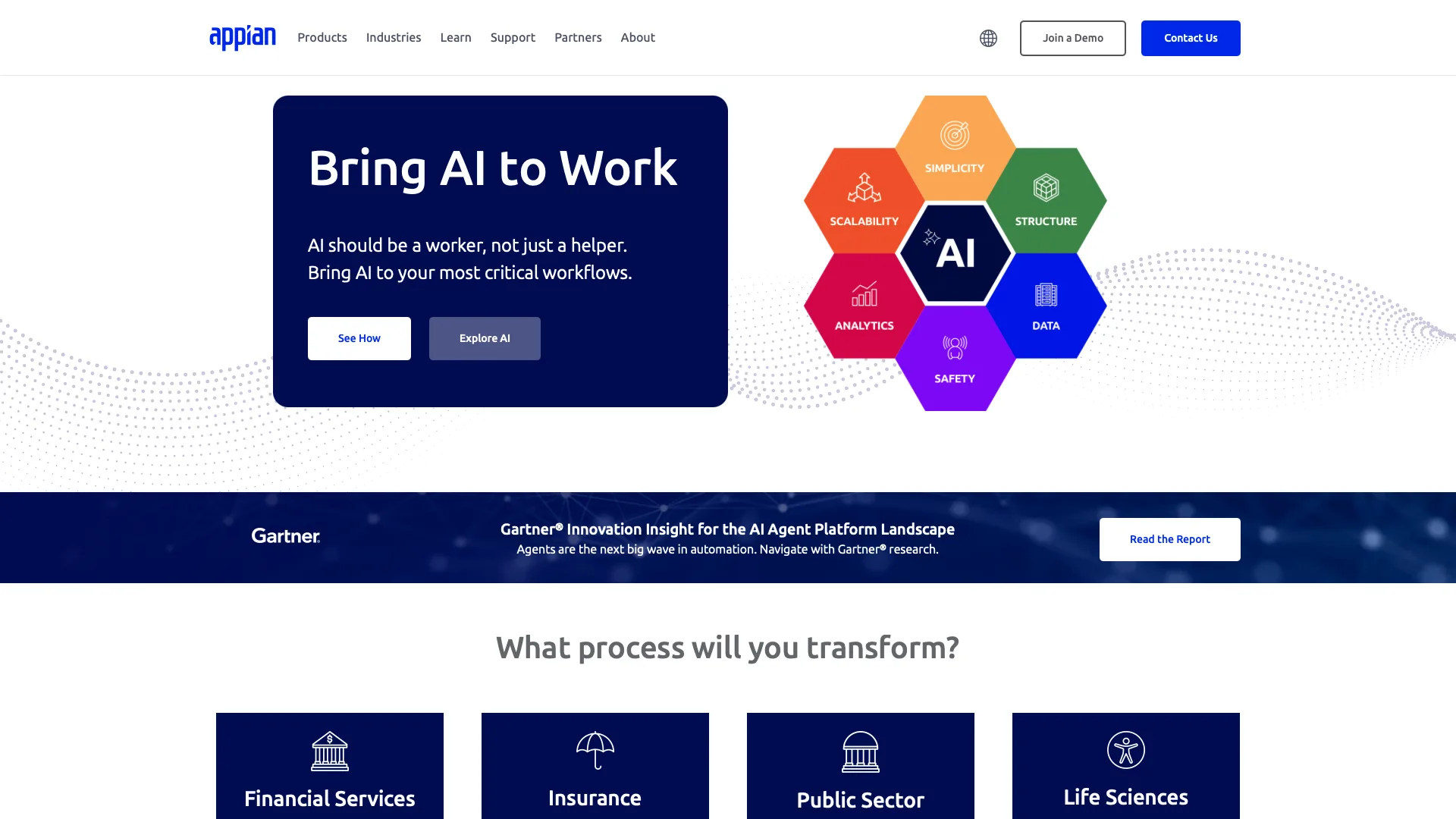 (Appian Website)
(Appian Website)
Pros
Appian offers some very advanced capabilities in the realm of automation. On top of its flowchart-based automation builder, there are dedicated tools for process modeling, RPA, machine learning, performance analytics, and more.
It’s also a strong offering in terms of AI capabilities, including tools for building, deploying, and managing agents with processes. Importantly, there’s also a range of features for putting guardrails in place around our AI-based automation systems.
Appian also offers Data Fabric, a unified data layer for connecting disparate sources across the enterprise.
Cons
However, Appian may not offer us the same degree of flexibility and customization as some other players in the low-code space when it comes to building UIs, compared to less automation-focused platforms.
On top of this, Appian’s UI builder may look and feel a little bit dated compared to some more modern tools.
Lastly, Appian is a somewhat enterprise-focused tool, so some of the capabilties on offer may be excessive for smaller teams or use cases.
Pricing
Appian’s pricing is based around three tiers, on a per-user per-month model - Standard, Advanced, and Premium.
The specific costs of these are not currently advertised on their pricing page.
Each tier implements distinct feature and usage restrictions. For example, we’ll need an Advanced license to access most AI capabilities.
5. Mendix
Next, we have Mendix. This is another one of the more established names in the low-code space. Like Retool, it’s also heavily targeted towards developers, especially within larger organizations.
So, we have some interesting functionality around integrating Mendix with various SDLCs, development processes, and other tools that are typically relied on by these kinds of teams.
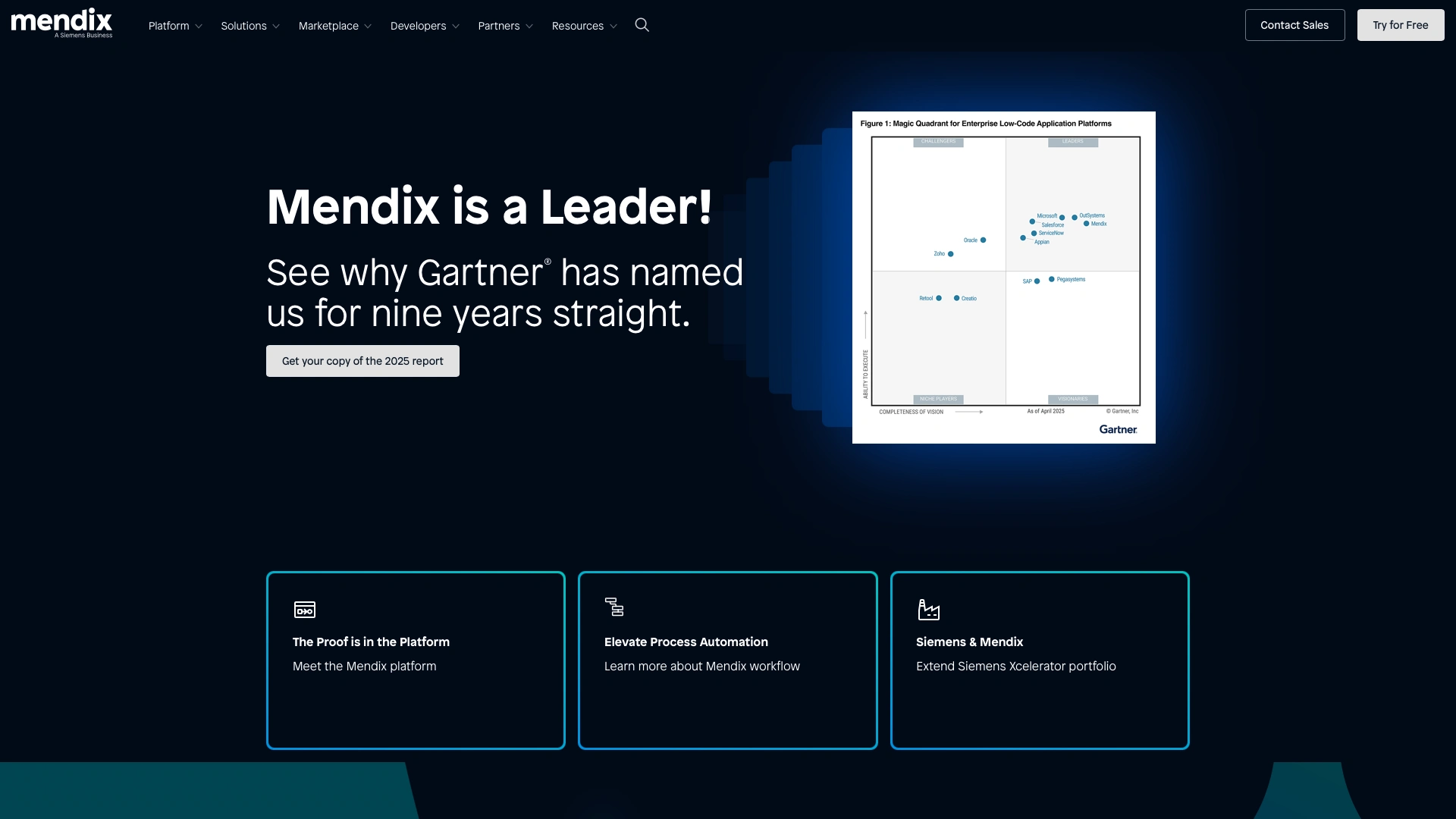 (Mendix Website)
(Mendix Website)
Pros
Mendix is centered around a visual IDE - Mendix Studio Pro. This combines a drag-and-drop UI for handling components with extensive scope for adding front-end scripting, business logic, and integrations. There’s also extensive AI capabilities across the entire SDLC.
Mendix is also highly extensible. There’s a proprietary SDK for building custom integrations, components, reusable scripts, and more. Therefore, it can be a very powerful option - assuming you have the technical skills to take advantage of this.
There’s also a very large, active community of developers, providing helpful resources, tips, extensions, and other contributions.
Cons
The place where Mendix really falls down is usability. It’s a comparatively code-intensive platform, even for performing relatively simple tasks. For example, we may need to write custom CSS for comparatively basic design customization.
Even aside from the high requirement for coding skills, Mendix presents a much steeper learning curve than many of the other tools we’ve seen.
It’s very enterprise-focused, meaning it will be prohibitively expensive for most smaller-scale projects.
Pricing
Compared to some other PowerApps alternatives, Mendix can be relatively expensive. There are three pricing tiers that allow us to build a single application - free, standard, and premium. Premium is the custom option for enterprises.
Standard bills at $998 per month. However, we’ll still need to pay additional fees for hosting and compute resources, which will be billed separately.
If you want to build for than one application in Mendix, the cheapest paid option is the standard tier at $2495 per month, plus additional user fees.
6. OutSystems
OutSystems is a slightly different proposition to most of our other FileMaker alternatives. It’s probably the most developer-focused tool in the low-code space - although it’s also widely used by other IT job roles.
As such, it offers some of the most extensive capabilities of the tools platforms in this round-up - but the trade-off here is that it also requires a lot more technical expertise from users.
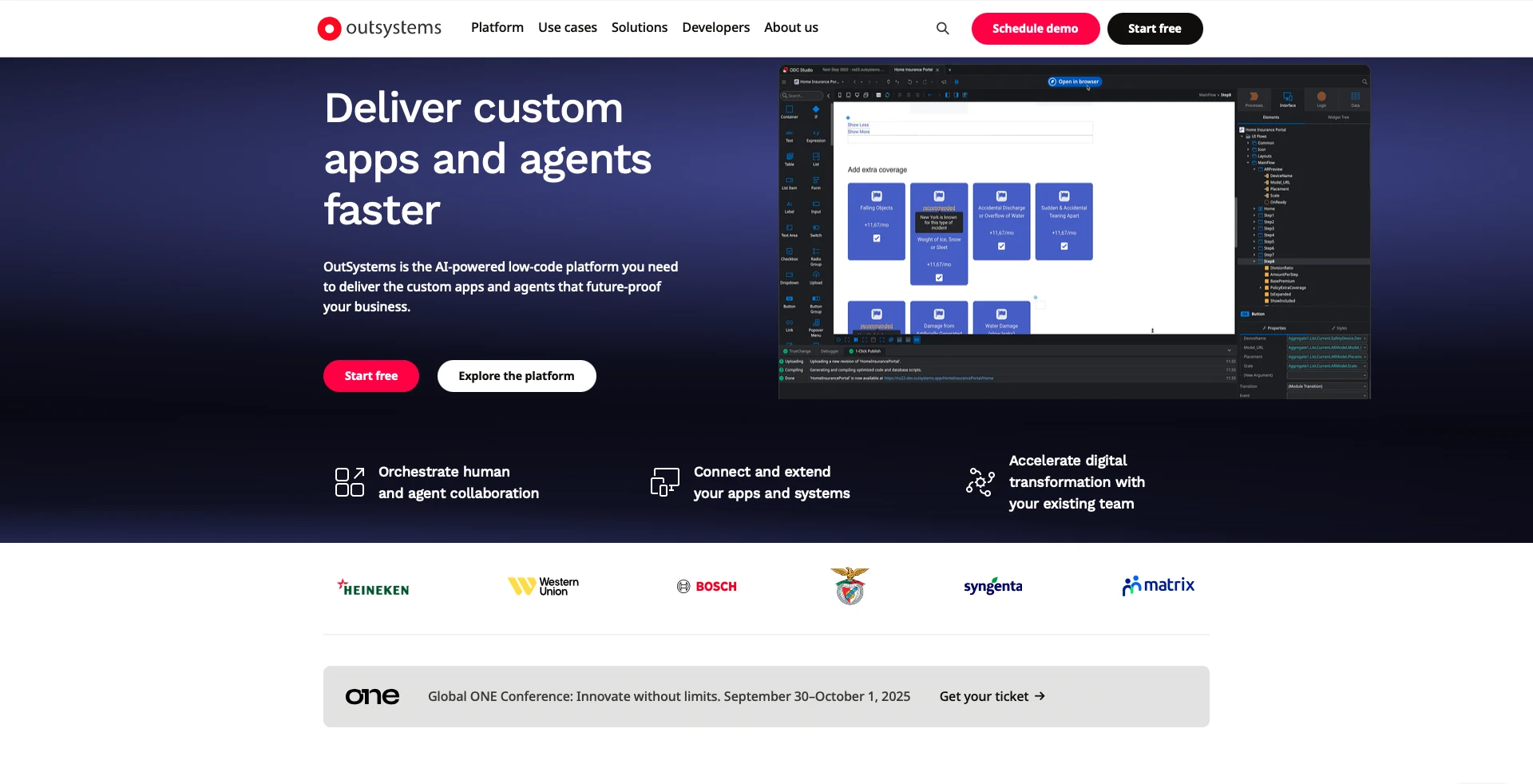 (OutSystems Website)
(OutSystems Website)
Pros
OutSystems outshines many other low-code platforms when it comes to advanced use cases. In particular, it’s a very strong offering in terms of multi-platform development - with specific capabilities for building PWAs, native mobile apps, and more.
It’s also hugely extensible. In particular, OutSystems offers a dedicated SDK, meaning that developers can build custom data sources, components, and other extensions. It also provides a native marketplace for community contributions.
Another area where OutSystem is particularly impressive is generative AI. There are effective tools for writing, testing, and monitoring custom code - but with the important caveat that this is most helpful if you have the expertise to understand the code itself. On top of this, we can use OutSystems to greatly accelerate AI agent development.
Cons
Unfortunately, the reality is that OutSystems will be beyond the technical skill level of most users who don’t have some development experience.
On top of this, the cloud-based version of OutSystems comes along with additional feature limitations.
At the same time, we might find that, in smaller teams, a more streamlined FileMaker alternative is more suitable for our needs, particularly if OutSystems’ more advanced capabilities are surplus to our requirements.
Pricing
OutSystems pricing is somewhat different to many of the other FileMaker alternatives we’ve seen so far. This utilizes a concept known as Application Objects (AOs) to calculate usage. An AO can be any aspect of how we build an application, including databases, tables, screens, API requests, and more.
Licenses for OutSystems Developer Cloud start from $36,300 for a single application with up to 100 internal users. We’ll then need to pay additional fees for extra users, building multiple apps, or 24/7 support.
Self-hosting is billed as an advanced add-on.
7. Airtable
Airtable is a slightly mdifferent take on many of the the same core problems that FileMaker set out to address.
Much like FileMaker, the goal is to provide teams with more advanced ways to store and manage data, without necessarily having the skills required to use a more traditional RDBMS tool.
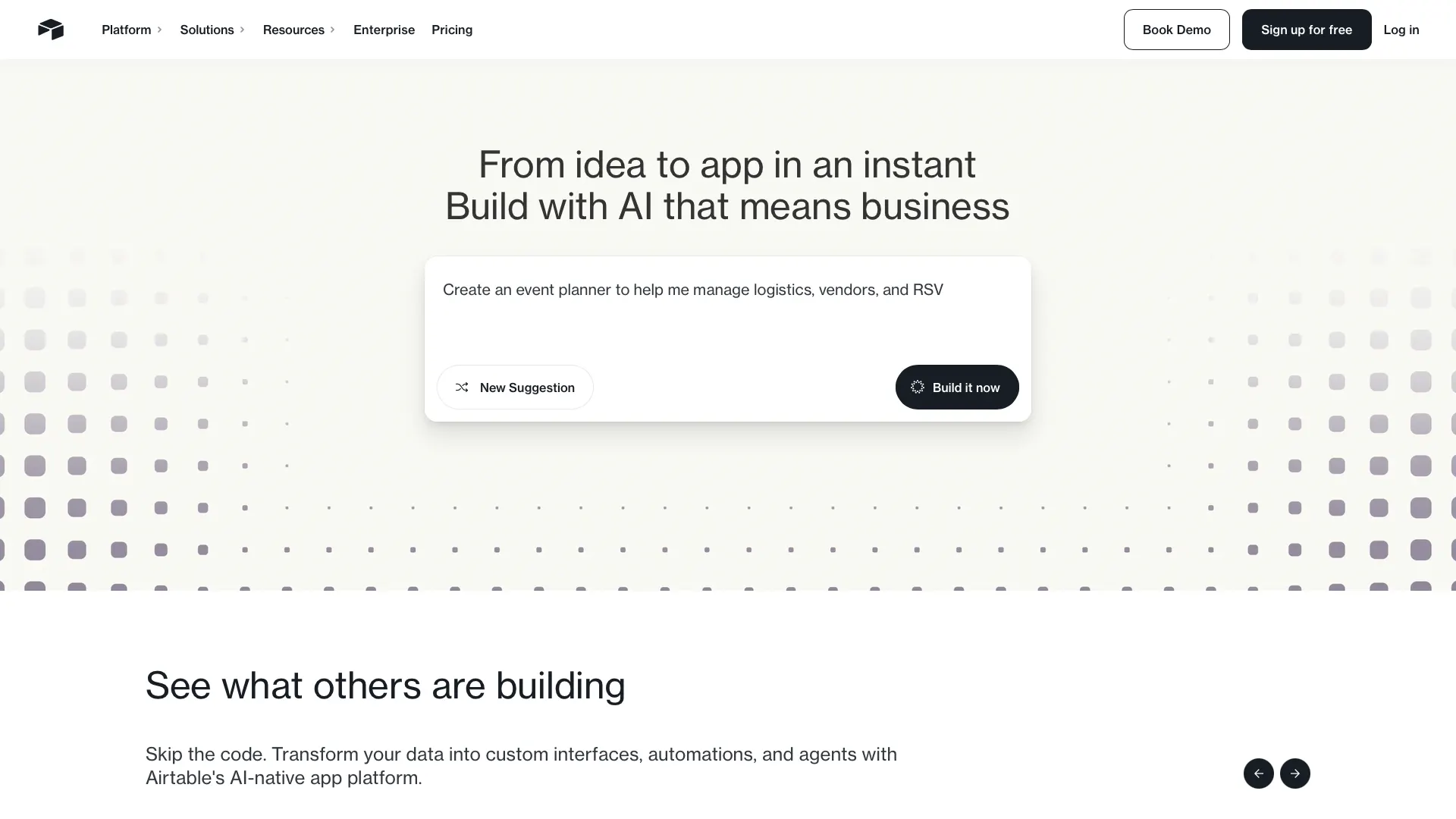 (Airtable Website)
(Airtable Website)
Pros
Airtable has achieved an enormous market share over the past decade thanks to its familiar, intuitive user experiences. Its core value proposition is that we can create and interact with fully functioning databases using spreadsheet-based UIs.
Like FileMaker, it also provides extensive tools for building end-user interfaces and automating workflows. Since Airtable is primarily a database tool, it’ll be no surprise that it’s particularly strong on forms, dashboards, and other reporting UIs.
Airtable also shines in terms of the speed and ease with which we can get up and running. There’s a huge library of templates for both database schemas and related app UIs, especially in the realms of project management, finances, internal processes, and more.
Cons
However, much like FileMaker, one of Airtable’s big downsides is that its primary goal is for teams to migrate their data ops to the platform. So, it’s relatively sticky, and external data support is mostly limited to external SaaS platforms and APIs - not other databases.
Compared to other tools in the no/low-code space, Airtable falls down on flexibility and customization. One big detraction relative to other tools we’ve seen today is that we can’t natively query SQL databases and use the responses within our front ends.
We’re also generally limited in terms of the front-ends we can build on top of our data. So, Airtable works very well in terms of shipping general data management apps but leaves more to be desired for less generic use cases.
Pricing
Airtable bills on a per-user basis, at least nominally. In practice, things are a bit more complex, as there are also restrictions across pricing tiers relating to stored data and automation runs. For example, the free tier gives us five users but only 1,000 rows per base.
The Team ($20) and Business ($45) tiers each impose their own limits on stored data and automations too. Additionally, since Airtable doesn’t distinguish between end users and creators, it can be quite an expensive platform to scale.
Custom pricing is required for more than 500,000 stored rows or monthly automation runs, as well as advanced security features. So, for larger use cases, you’ll probably want to look at a traditional DBMS instead.
Take a look at our round-up of the top Airtable alternatives .
8. Zoho Creator
Lastly, we have Zoho Creator. Again, this puts a slightly different spin on low-code development than some of the other tools we’ve seen so far today.
It’s a particularly strong platform for IT teams who want to empower their on-the-ground colleagues to build solutions for themselves in a controlled manner - for instance, within a citizen development program.
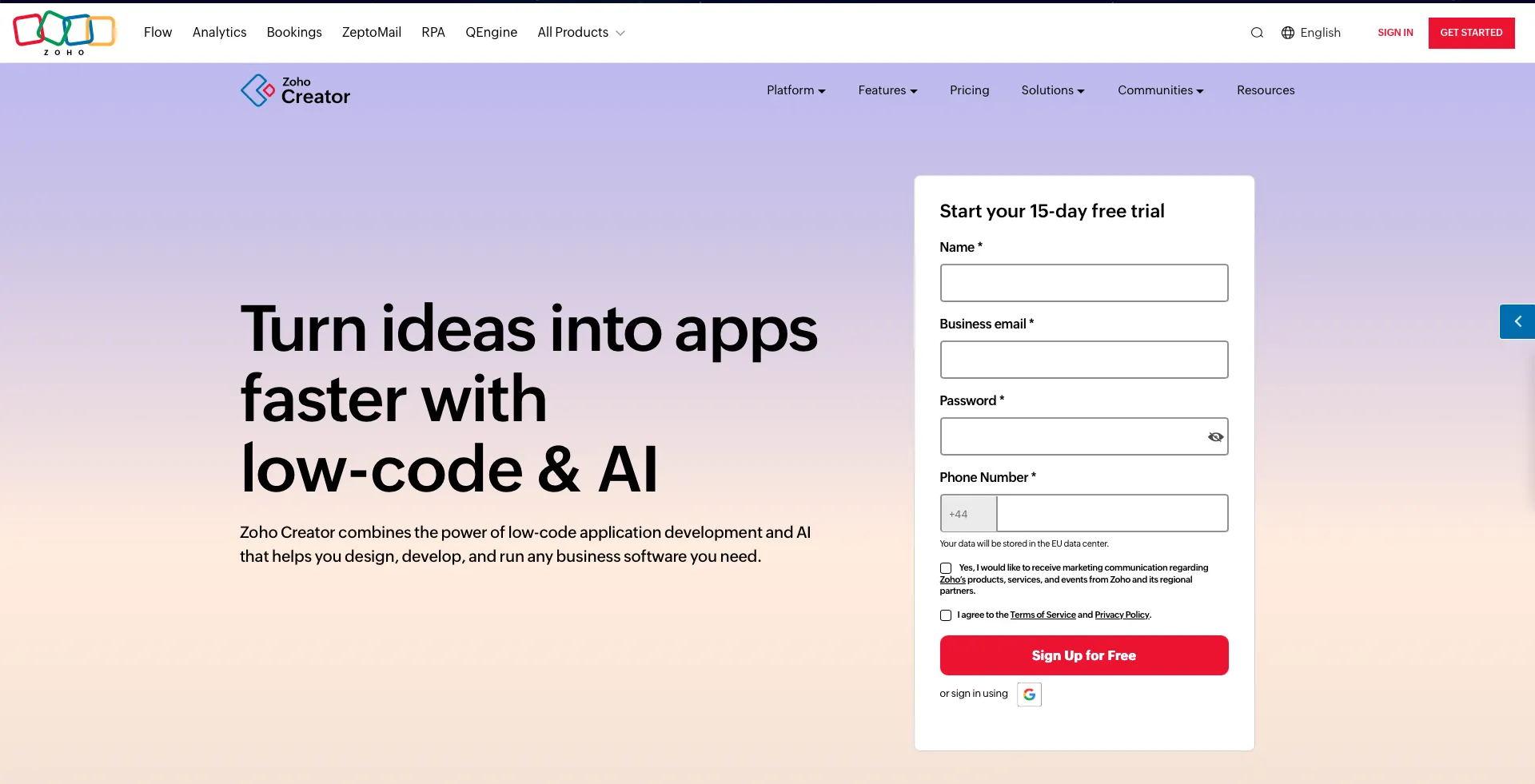 (Zoho Creator Website)
(Zoho Creator Website)
Pros
One of Creator’s big strengths is integrability. In fact, it offers a wide array of native integrations for external SaaS tools, CRMs, ERPs, and more, as well as intuitive, flexible experiences for configuring API requests.
It’s also a strong offering in terms of security and governance. With flexible RBAC, custom security policies, and more, IT teams can create highly granular frameworks for governing how users interact with data assets and other resources.
A great benefit of Creator for less technical teams is that we can use natural language prompts to output fully working applications.
Cons
Some Creator users complain that there’s a comparative lack of design customization, with end-user applications being limited to a small number of built-in themes. Often, app designs may also feel a little dated compared to some other platforms in this class.
As a platform that’s optimized for IT teams empowering their on-the-ground colleagues to build tools, it can also leave a little bit to be desired for one kind of user or other acting in isolation.
For instance, we might need custom code to perform certain kinds of tasks - putting it beyond the skill level of most non-technical users, but at the same time, the degree of customization on offer might not be sufficient for developers or IT specialists.
Pricing
Creator’s pricing is based on three fixed monthly per-user tiers - Standard, Professional, and Enterprise, as well as the option for custom pricing. This has the potential to be very cost-effective, although it’s worth noting that there’s no fully-featured free tier.
Pricing is also a little bit less predictable than some other vendors in the low-code space. There are additional usage-based limits based on both automation runs and connected data, so we might need to upgrade to a premium tier as a result of these.
Certain enterprise features like SSO are available on all tiers but billed as an optional extra for Standard and Professional licenses, which could be a great fit for smaller security-conscious teams.
FileMaker vs Budibase
Now that we’ve seen a range of options from across the low-code market, we can dive a little deeper into how FileMaker and Budibase compare to one another.
Both platforms are designed to improve the way teams manage data and create internal tools.
However, in practice, they take very different approaches to achieving this. Let’s break this down.
Data
At its core, FileMaker is a database platform that gives non-technical users a solution to improve the way they handle internal data - especially if this would otherwise mean reliance on spreadsheets.
Ultimately, the goal is for teams to adopt FileMaker instead of using a more advanced DBMS. They can then build applications and automate workflows on top of this.
Budibase is optimized for building internal tools on top of all sorts of existing data. We offer native connectors for all kinds of SQL and NoSQL databases, Google Sheets, and REST APIs - as well as custom data sources via our plug-ins CLI.
Like FileMaker, we also offer a built-in, low-code database, with full support for CSV uploads - so users can build their data model from scratch with minimal development experience.
UIs
FileMaker can be somewhat more limited than many alternatives when it comes to building UIs. Some users complain that there’s a lack of flexibility when it comes to designing screens and app theming.
For the most part, it’s best suited to building things like forms and reports, but you might want to look elsewhere for tools that relate to more complex business logic.
At Budibase, our UI builder makes custom code totally optional. You can add front-end logic with JavaScript or our library of built-in handlebars helpers. We can even autogenerate a range of different types of app screens based on connected data schemas.
But you can also add conditionality, mobile responsiveness, complex filtering, design customization, and more with no prior development skills.
Automations
Automations in FileMaker are script-based. But we don’t necessarily have to do this from scratch. Remember, the platform isn’t really aimed at professional developers. So, they provide a library of script steps that can be combined to create custom rules. More recently, they’ve also launched a range of capabilities for implementing advanced AI techniques within applications.
Budibase’s flow-based automation editor offers a much more effective experience for non-developers. Simply combine our built-in trigger and action blocks to build highly configurable automation rules, including custom LLM prompts and pre-build AI actions. Add looping or branching logic to automate complex, end-to-end processes with ease.
We also offer support for custom scripting using JavaScript within automations.
How to choose a FileMaker alternative
Lastly, we need to restate that no low-code platform is fully optimized for every possible use case or organization. Instead, we need to have a realistic picture of the kinds of decision points we’re most likely to encounter when choosing a FileMaker alternative.
We’ve hinted at many of these already. For instance, we know that platforms offer varying scope for adding custom code vs empowering users with lesser technical skills.
Here’s a breakdown of what you’ll need to consider to choose a FileMaker alternative.
Pricing
The most obvious calculation we’ll want to make is around costs. At first glance, this might seem relatively straightforward since most platforms in this space bill on a per-user basis.
But, in reality, things are a bit more complicated than that. Some platforms treat different kinds of users differently, while others treat them all the same. Vendors also impose very different feature restrictions and usage limits across their pricing tiers.
This can mean that we might need a more expensive license for certain vendors in order to access certain functionality.
User personas
We’ve seen extensively that each of the FileMaker alternatives in our guide today aims to help different kinds of users manage data and build applications.
The starkest aspect of this is their level of technical abilities. So, some platforms are aimed at business-level users with very little technical skills. Others are essentially platforms for professional developers.
In between, we have tools that target users with some coding ability - who fall short of the skill levels of actual software engineers.
Scalability
Scalability is the ease with which we can add new capacity to the applications we build in our chosen low-code platform - whether this is adding new data, users, capabilities, or some other factor.
There are two things to consider here. One is the actual technical side of scaling our usage. For example, some tools don’t support NoSQL database connections, so they won’t be much use with larger data sets that leverage these kinds of platforms.
The other thing is the cost of scaling.
So we need to be cognizant of the fact that we’ll encounter various user limits and feature restrictions that will mean we need to upgrade within different vendor’s pricing models as our needs change.
Costs are also impacted by how vendors treat different kinds of users. Generally, it’s cheaper to scale if there’s a distinction between creators/administrators and end users than it is if these are all billed equally.
Extensibility
Extensibility is how easily we can add new capabilities to a platform or integrate it with our wider tool stack. Nowadays, most platforms allow you to connect to external tools via API requests and WebHooks.
However, some offer additional functionality - like their own internal APIs which can be used to add even greater capabilities. Others offer custom plug-ins or even SDKs for adding to native functionality.
In the world of low-code development, however, the most important thing is external data support. That is, the kinds of existing data sources that a platform enables you to interact with natively.
Open-source vs closed-source
Lastly, we have the issue of open-source vs closed-source platforms. Open-source software is a top priority for many businesses - especially enterprises or organizations that deal with large volumes of sensitive data.
Essentially, the power to audit the source code of any tools that will be hosted or internal infrastructure or interact with production data is a core security issue for these kinds of businesses.
Here’s how the tools we’ve seen today break down in this regard.
 Filemaker |  Budibase |  Retool |  Mendix |  PowerApps |  Appian |  Outsystems |  Airtable |  Zoho Creator | |
|---|---|---|---|---|---|---|---|---|---|
| Open-source vs Closed-source | Closed-source | Open-source | Closed-source | Closed-source | Closed-source | Closed-source | Closed-source | Closed-source | Closed-source |